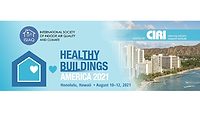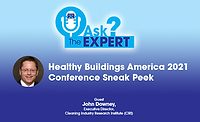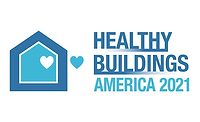Healthy Buildings America Conference Transitions to a Live Virtual Format

To protect the health and safety of all attendees, presenters and staff, organizers for the Healthy Buildings Conference will host the upcoming conference, scheduled to take place Jan. 18-20, 2022, in a virtual format. This live event, sponsored by the International Society of Indoor Air Quality and Climate (ISIAQ) and hosted by the Cleaning Industry Research Institute (CIRI) will feature more than 200 science-based oral presentations, poster presentations and workshops focused on “Bridging the Gap Between Research and Practice — In the Age of COVID-19 and Beyond.”
“Particularly now, as new COVID-19 variants proliferate, everyone wants a better understanding of how to keep our buildings healthy and safe,” said John Downey, executive director of CIRI. “This change in plans is not totally unexpected given all the uncertainty of the past two years. We are well prepared to deliver an abundance of new research in a real-time, virtual format.”
The three-day conference will include three tracks, each containing multiple 90-minute sessions organized around key themes, such as the impact of indoor air quality on health, comfort, productivity and perception, sources and health effects, cleaning and disinfection, ventilation, SARS-CoV-2 transmission and more.
Most sessions will feature up to eight short “lightning” presentations with a live Q&A. Others will be in an interactive workshop format, including two to three presentations around a specific topic. Each workshop will also include a panel discussion and a question and answer session with presenters. All content will be searchable by topic and author, allowing attendees to determine preferred schedules.
In addition to oral and poster sessions and workshops, Healthy Buildings will feature plenary talks from renowned experts from research and practice.
Restoration and remediation sessions include:
- ATP Testing: Use and Misuse in Water Loss Restoration, by Dr. Ralph Moon
- Understanding The Big Picture Of Remediation Of A Water Damaged Building With Sensitized Occupants, by Michael Pinto
- Microbial growth and mVOC emissions from building materials associated with increased moisture, by Dr. Sarah Haines, Emma Hall, Katarzyna Marciniak, Dr. Pawel Misztal, Prof. Allen Goldstein, Dr. Rachel Adams, Dr. Karen Dannemiller
- Advances in Monitoring Technologies for Interior Environments: The Changing Face of Formaldehyde Analysis, by Dr. Caroline Widdowson, Dr. Dustin Poppendieck
- Putting ‘Emerging Technology’ Air Purification Devices to the Test, by Jacob Persky, Dr. Frank Pagone, Mr. Luke Nienhaus
“To create and maintain healthy buildings, we first need to understand the research,” added Downey. “Attendees to this conference will leave equipped with the scientific data they need to make informed decisions around creating and maintaining healthy indoor spaces.”
Additional educational offerings will be offered by leading names such as:
- Joseph G. Allen, associate professor at the Harvard T.H. Chan School of Public Health and co-author of Healthy Buildings: How Indoor Spaces Drive Performance and Productivity
- Terry Brennan, building scientist, educator and author of the USEPA Moisture Control For Commercial Building Design, Construction, Operations And Maintenance Guidance. With a background in physics, biology and building construction, Brennan combines theory and practice in a unique and integrated way.
- Lidia Morawska, professor at the Queensland University of Technology (QUT) in Brisbane, Australia, and the director of the International Laboratory for Air Quality and Health (ILAQH) at QUT, which is a Collaborating Centre of the World Health Organization on Research and Training in the field of Air Quality and Health. Professor Morawska was recently identified as one of Time Magazine’s “100 Most Influential People of 2021.”
- Jordan Peccia, associate professor of environmental engineering at Yale University. Peccia’s research integrates engineering and public health approaches with quantitative molecular biology tools to study human exposure to microbes in the built environment.
- Anita van Breda is senior director of environment and disaster management at the World Wildlife Fund. With more than 20 years of experience in conservation and disaster management, she currently leads WWF’s work supporting environmentally responsible disaster recovery, reconstruction, and risk reduction including international policy, operations, and training, and is a member of the WWF Internal Covid-19 Working Group.
- Greg Whiteley, chairman of Whiteley Corporation and adjunct fellow in the School of Medicine at Western Sydney University.
The cost for attendance to this three-day live virtual conference is $370 for CIRI and ISIAQ members ($220 for student members) and $505 for non-members ($250 for student non-members). For those unable to attend the live event, recorded sessions will be made available at a later date. One year of free ISIAQ membership is offered as part of the non-member registration, providing registrants with access to a full library of additional webinars and research materials.
To learn more about this conference, please visit https://hb2021-america.org or go to https://mms.isiaq.org/members/evr/reg_event.php?orgcode=ISIA&evid=25477157 to register.
About CIRI
Cleaning Industry Research Institute (CIRI) is the only independent and impartial institute focused on cleaning and building maintenance research. Its purpose is to improve cleaning and restoration outcomes and indoor environmental quality (IEQ) for all indoor environments. CIRI is a 501.c.3 nonprofit scientific, educational and research institute recognized for its groundbreaking cleaning science and research programs. As such, CIRI serves the dual purpose of serving both the “public good” as well as the cleaning and restoration industries. CIRI does not compete with existing organizations; rather, it serves a unique, complementary role and works with all leading industry groups.
About ISIAQ
ISIAQ is an international, independent, multidisciplinary, scientific, non-profit organization whose purpose is to support the creation of healthy, comfortable and productive indoor environments. We strongly believe this is achievable by advancing the science and technology of indoor air quality and climate as it relates to indoor environmental design, construction, operation and maintenance, air quality measurement and health sciences.
Looking for a reprint of this article?
From high-res PDFs to custom plaques, order your copy today!





